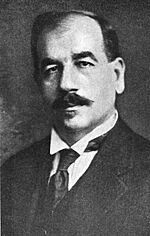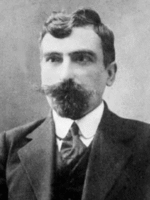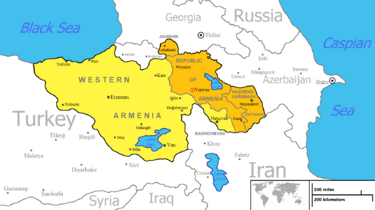Armenian Revolutionary Federation facts for kids
Quick facts for kids
Armenian Revolutionary Federation
Հայ Յեղափոխական Դաշնակցութիւն
|
|
|---|---|
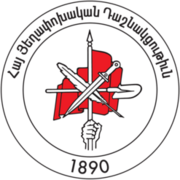 |
|
| Other name | Dashnaktsutyun |
| Abbreviation | ARF (English) ՀՅԴ (Armenian) |
| Bureau Chairman | Hakob Ter-Khachaturyan |
| Supreme Council Chairman |
Ishkhan Saghatelyan |
| Founders | Christapor Mikaelian Stepan Zorian Simon Zavarian |
| Founded | 1890 in Tiflis, Russian Empire (now Tbilisi, Georgia) |
| Headquarters | Mher Mkrtchyan 12/1, Yerevan |
| Newspaper | Yerkir (Երկիր, "Country") and Droshak (Դրօշակ, "Banner") |
| Student wing | ARF Shant Student Association ARF Armen Karo Student Association |
| Youth wing | Armenian Youth Federation |
| TV Channel | Yerkir Media (in Armenia) |
| Membership (2012) | 6,800 (in Armenia only) |
| Ideology |
|
| Political position | Centre-left to left-wing |
| National affiliation | Homeland Salvation Movement (in Armenia; 2020–2021) Armenia Alliance (in Armenia) March 8 Alliance (in Lebanon) |
| European affiliation | Party of European Socialists (observer) |
| Continental affiliation | Forum of Socialists of the CIS Countries |
| International affiliation | Socialist International (1951–1960; 1996–present) Labour and Socialist International (1923–1940) Second International (1907–1916) |
| Colors | Red and gold |
| Slogan | "Ազատութիւն կամ մահ" Azatut'yun kam mah ("Freedom or Death") |
| Anthem | "Մշակ, բանուոր" Mshak Banvor ("Peasant and Worker") |
| Affiliates | Armenian Relief Society Homenetmen Hamazkayin Armenian National Committee of America |
| National Assembly of Armenia |
10 / 107
|
| Parliament of Lebanon |
3 / 128
|
| Party flag | |
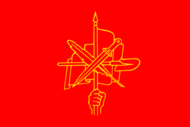 |
|
|
^ a: United Armenia is an irredentist concept referring to areas within the traditional Armenian homeland. The ARF idea of "United Armenia" incorporates claims to Western Armenia (eastern Turkey), Nagorno-Karabakh (Artsakh), the landlocked exclave Nakhichevan of Azerbaijan and the Javakheti (Javakhk) region of Georgia. |
|
The Armenian Revolutionary Federation (ARF), also known as Dashnaktsutyun, is an Armenian political party. It was started in 1890 in Tiflis, which was then part of the Russian Empire. Today, Tiflis is known as Tbilisi, the capital of Georgia. The party was founded by Christapor Mikaelian, Stepan Zorian, and Simon Zavarian.
As of 2023, the ARF is active in Armenia, Lebanon, Iran, and in many countries where Armenians live around the world. It was also active in Artsakh until September 2023. The ARF is very important to Armenians living outside of Armenia. However, it has a smaller presence in the Republic of Armenia itself. In October 2023, the party had ten seats in the Armenian Parliament and three seats in the Parliament of Lebanon.
The ARF has always supported a type of government called socialist democracy. It has been a full member of the Socialist International since 2003. This is a group of political parties from around the world that share similar ideas about fairness and equality. The ARF has many members in the Armenian diaspora, with groups in over 20 countries. Unlike some other Armenian groups that focus on education or helping people, the ARF is more focused on politics. It strongly supports Armenian nationalism, which means promoting Armenian culture and interests.
The party works to get the Armenian genocide recognized by countries around the world. It also seeks fair payments for the harm caused by the genocide. The ARF also wants to create a "United Armenia." This idea is partly based on a treaty from 1920.
Contents
The ARF's Beginnings
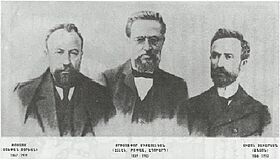
In the late 1800s, many small Armenian groups in the Russian Empire wanted to make changes in Armenian areas of the Ottoman Empire. In 1890, Christapor Mikaelian, Simon Zavarian, and Stepan Zorian brought these groups together. They formed a new political party called the "Federation of Armenian Revolutionaries." This party later became known as the "Armenian Revolutionary Federation" or "Dashnaktsutiun."
The ARF's main goal was to help Armenians in the Ottoman Empire gain political and economic freedom. They planned to do this through armed resistance. In the 1890s, the party worked to unite smaller groups in the Ottoman Empire. These groups wanted reforms and aimed to protect Armenian villages from attacks and violence. ARF members formed groups of fighters called fedayi. These fighters defended Armenian civilians through armed resistance.
At first, the party focused on getting self-rule and democratic rights for Armenians in both the Russian and Ottoman Empires. In 1919, they changed their goal to creating an independent and united Armenia.
Challenges in the Russian Empire
The ARF became very popular among Armenians in the Russian Empire. The Russian government supported the ARF's goals against the Ottoman Empire until 1903. However, on June 12, 1903, the Russian government decided to take control of all Armenian Church property. The ARF strongly opposed this. They saw it as a threat to Armenian identity.
The ARF leaders decided to protect Armenian churches. They sent militiamen to guard them and organized large protests. In 1904, the party changed its policy. It began to fight against the Russian government. They even carried out actions against government officials. They also set up their own schools, courts, and prisons in Russian Armenia.
During the Armenian-Tatar massacres in 1905–06, the ARF became involved in armed activities. Some people believe the Russian government encouraged these massacres. This was to strengthen its power during the 1905 revolution. The ARF blamed the Russian authorities for not acting and for causing the violence. The ARF said it helped organize the defense of Armenians against attacks.
In January 1912, 159 ARF members were put on trial in Russia. They were lawyers, bankers, and other educated people. They were accused of being involved with the party. A lawyer named Alexander Kerensky defended them. He showed that much of the evidence against them was unfair. Many of the accused were found not guilty. Others were imprisoned or sent away for a time.
The ARF in the Persian Empire
The Dashnaktsutiun held a big meeting in 1907. ARF leaders discussed getting involved in the Iranian Constitutional Revolution. They believed this movement would bring law, order, and human rights to all people, including Armenian-Iranians. The ARF helped the revolution mostly by sending its skilled fighters to Iran.
A famous ARF member already in Iran was Yeprem Khan. He had started a branch of the party there. Yeprem Khan was very important in the Iranian Constitutional Revolution. He worked with other revolutionary leaders against the Shah. The ARF and Yeprem Khan won many battles. They even captured the capital city of Tehran in 1909. Yeprem Khan was then made chief of Tehran police.
The ARF in the Ottoman Empire
Fighting for Rights (1894–1908)
The ARF became a very important political group for Armenians. It was especially active in the Ottoman Empire. There, it organized or took part in many revolutionary actions. The ARF was good at teaching people and getting their support. They used this to gain allies and strengthen their community ties.
For example, in 1894, the ARF helped in the Sasun Resistance. They gave weapons to local people to help them defend themselves. This was against attacks by the Ottoman government. In 1896, the Armenakan Party organized the Van Rebellion. The Armenakans, with help from the ARF, armed the men of Van. They rose up to protect civilians from attacks.
To make people aware of the massacres in 1895–96, ARF members took over the Ottoman Bank in 1896. They wanted to show their demands for reforms in Armenian areas of the Ottoman Empire. They also wanted to get Europe's attention. The action did get Europe's attention. However, it also led to more massacres by the Sultan.
Many famous thinkers joined the ARF during this time. These included Avetik Isahakyan, Levon Shant, and Siamanto.
The Khanasor Expedition happened on July 25, 1897. Armenian fighters attacked the Kurdish Mazrik tribe. This was because the Mazrik tribe had attacked Armenian defenders during the Defense of Van. Some Armenians see this as their first victory over the Ottoman Empire. They celebrate it every year.
In 1904, the ARF played a big part in the Second Sasun Uprising. The ARF sent weapons and fighters to defend the region. Famous figures like Kevork Chavush took part. Even though they had fewer fighters, they held off the Ottoman army for months. But Ottoman forces eventually captured Sasun and killed many Armenians.
In 1905, ARF members planned to assassinate Sultan Abdul Hamid II. This was in response to the massacres. The plan, called the Yıldız Attempt, failed. The explosion missed the Sultan by a few minutes.
Working with the Young Turks (1908–1914)
In the 1890s, the party used armed actions against the Ottoman Empire and Russia. Their goal was to gain an independent nation.
The ARF worked with the Committee of Union and Progress, also known as the Young Turks. This group was trying to overthrow Sultan Abdul Hamid II. In 1907, the ARF agreed that Armenian and Turkish revolutionaries had similar goals. They hoped that if the Young Turks came to power, Armenians would get more self-rule.
In 1908, Sultan Abdul Hamid II was overthrown. This started a new period in the Ottoman Empire. The Dashnaktsutiun became a legal political party. Armenians gained more seats in the parliament. However, the reforms were not as much as the ARF had hoped for. The Adana massacre in 1909 also created bad feelings between Armenians and Turks. The ARF ended its cooperation with the Young Turks in 1912.
World War I and the Armenian Genocide
In 1915, many ARF leaders and other Armenian thinkers were deported and killed. This was part of a purge by Ottoman officials. The ARF led the defense of the Armenian people during the Armenian genocide. They were leaders of the successful Van Resistance. Aram Manukian, an ARF leader, became governor of the Armenian area and worked to help Armenians.
After World War I, members of the Young Turks movement were assassinated. The ARF believed they were responsible for the Armenian genocide. This was part of an operation called Operation Nemesis.
Forming the First Republic of Armenia (1918–1920)
When the Russian Empire collapsed in 1917, Armenian, Georgian, and Azerbaijani leaders in the Caucasus formed the Transcaucasian Federation. This group lasted only three months. Then, the Republics of Armenia, Georgia, and Azerbaijan were declared. ARF members were the negotiators for Armenia.
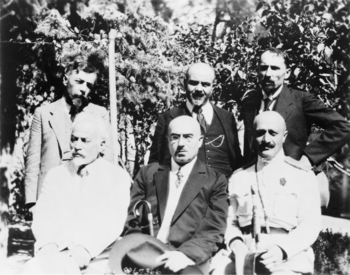
When the Transcaucasian Federation broke apart, the Armenians had to defend themselves. The Turkish army was moving towards Yerevan, the capital. At first, the Dashnaks thought about leaving Yerevan. But the Military Council decided to fight. They met the Turkish army on May 28, 1918, near Sardarapat. The Battle of Sardarapat was a big victory for the Armenian army. It stopped the Turkish forces.
The First Republic of Armenia was declared on the same day as the Battle of Sardarapat. The ARF became the ruling party. However, the new country was in a very bad state. Its economy was ruined, there were many refugees, and most people were starving.
The ARF had a strong presence in the government. Most important government jobs were held by its members. In 1920, the situation got worse. Soviet Russia and Turkey became closer. When the Turkish-Armenian war started in late 1920, Armenia was alone. The League of Nations did not help. Soviet Russia put more pressure on Armenia. Armenia lost the war and signed a treaty that gave away large areas to Turkey. The ARF gave up power to the Soviet Red Army. The ARF was banned, its leaders were sent away, and many members went to other parts of the world.
The ARF in Exile
After the Soviet Union took control of Armenia, the ARF moved its operations to where Armenians had settled outside of Armenia. Many Armenian refugees went to Lebanon and Syria. The ARF built a strong political presence there. From 1921 to 1990, the Dashnaktsutiun set up political groups in over 200 countries, including the USA.
During this time, there were also religious divisions. Some parts of the Armenian Church wanted to be separate from the main church in Armenia. This was because some Armenians in the US thought Moscow was using the church to spread Communist ideas. This led to the Armenian Church splitting into two branches. In the US, churches connected to the main branch would not allow ARF members. This caused the ARF to encourage people to attend churches from a different branch of the church.
During World War II, some ARF members in German-controlled areas worked with Nazi Germany. However, this was not the official position of the whole party. The party's main group in Cairo said they were loyal to the Allies. The main reason for this cooperation was likely to protect Armenians living in German-occupied areas. It was also to protect Armenia from a possible Turkish invasion if Germany won the war.
In the 1950s, there were disagreements between the ARF and Soviet Armenia. This led to fights within the Armenian community, especially in Lebanon. The ARF still felt angry about being forced out of Armenia. They wanted a "Free, Independent, and United Armenia," free from both Soviet and Turkish control. Other Armenian parties supported the new Soviet rule in Armenia.
The ARF in Lebanon
| Year | Mandates | ||
|---|---|---|---|
| 1943 |
1 / 55
|
||
| 1947 |
2 / 55
|
||
| 1951 |
2 / 77
|
||
| 1953 |
1 / 44
|
||
| 1957 |
2 / 66
|
||
| 1960 |
4 / 99
|
||
| 1964 |
4 / 99
|
||
| 1968 |
4 / 99
|
||
| 1972 |
1 / 99
|
||
| 1992 |
1 / 128
|
||
| 1996 |
1 / 128
|
||
| 2000 |
2 / 128
|
||
| 2005 |
2 / 128
|
||
| 2009 |
3 / 128
|
||
| 2018 |
3 / 128
|
||
| 2022 |
3 / 128
|
||
From 1923 to 1958, there were conflicts among Armenian political parties in Lebanon. They were trying to control and organize the Armenian community. In 1958, an armed conflict broke out between ARF supporters and their opponents.
Before the Lebanese Civil War (1975–90), the ARF was close to another party called the Phalangist Party. They often worked together in elections. However, the ARF and most Armenian groups did not want to take an active part in the civil war. This made relations between the two parties difficult. The Lebanese Forces, a militia, attacked Armenian areas. Many Armenians linked to the ARF took up arms to defend their neighborhoods.
Armenians in Lebanon have six seats in the country's parliament. The ARF in Lebanon usually won most of these seats. However, in the 2000 election, the ARF only won one seat. This was its worst result in many years. In the 2009 elections, the ARF won 2 seats. In June 2011, ARF members were given two government minister positions.
The ARF's Lebanon office is in Bourj Hammoud. It also has a newspaper and a radio station there. As of February 2025, the ARF holds one position in the Lebanese government, the Sports Ministry.
The ARF in Independent Armenia
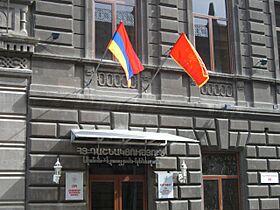
The ARF has always wanted a "Free, Independent, and United Armenia." This idea of "United Armenia" includes areas recognized by U.S. President Woodrow Wilson in the Treaty of Sèvres. After Armenia came under Soviet control in 1920, the ARF in the Armenian diaspora opposed Soviet rule. They worked to keep Armenian identity alive. Because of strict Soviet control, the ARF could not operate in Armenia. The party was banned until 1991.
When Armenia became independent in 1991, the ARF quickly became one of the most active political parties. However, on December 28, 1994, President Levon Ter-Petrosyan banned the ARF. He said the party was planning to harm Armenia's security and overthrow the government. Government forces arrested ARF leaders and seized their offices. The president's adviser later said he was not sure if the evidence was true. He suggested the party was banned because it was becoming too popular. The trials were seen as politically motivated by many.
The ban on the party was lifted in February 1998. This happened after Ter-Petrosyan left power and Robert Kocharyan became president. Most ARF members who had been arrested were released.
In 2007, the ARF had a cooperation agreement with the ruling government. With 16 out of 131 seats, the ARF was the third-largest party in parliament. ARF members also led several government ministries. In 2007, the ARF held a special election for the public to choose their candidate for president. Vahan Hovhannisyan won and was nominated. In the 2008 presidential election, he came in fourth.
In 2009, the ARF left the government coalition and became an opposition party. In the 2012 parliamentary election, the ARF won 5 seats, which was 11 fewer than in 2007. The ARF rejoined the government in February 2016. They received three minister positions.
After the 2016 Nagorno-Karabakh clashes, the ARF helped the Ministry of Defense create a volunteer army group. This unit was made up mostly of party members. It included experienced commanders and soldiers.
After the 2017 elections, the party won 7 seats in the parliament. However, after the 2018 Armenian Velvet Revolution, the ARF left the government coalition. They became an opposition party. In the 2018 election, the party only got 3.89% of the votes. This was less than the 5% needed to have seats in parliament. It was the first time since Armenia's independence that the ARF had no political representation.
Since 2018, the ARF has been the main opposition party outside of parliament. The party also helped people in need in Armenia, especially in rural areas. They provided aid during the 2020 COVID-19 pandemic. This was thanks to donations from Armenians living abroad.
During the 2020 Nagorno-Karabakh War, the ARF again formed volunteer groups to fight. After the war, the party joined 16 other political parties. They formed the "Homeland Salvation Movement." This group called for the Prime Minister to resign. The ARF supported former prime minister Vazgen Manukyan as their candidate.
The ARF formed an alliance called the Armenia Alliance for the 2021 parliamentary election. This alliance won 29 out of 107 seats. Ten of these seats were taken by ARF candidates.
Electoral Record In the 2000s, the party usually got about 10 to 15 percent of the votes in national elections. After the 2018 Armenian Velvet Revolution, the party's support dropped to 1–2%. However, the party gained 10 seats in parliament in the 2021 elections as part of the Armenia Alliance.
The ARF in Artsakh
After the Soviet Union took over the South Caucasus, it created the Nagorno-Karabakh Autonomous Oblast in 1923. In the last years of the Soviet Union, the ARF started a group in Nagorno-Karabakh. In January 1991, the Dashnaktsutiun won the parliamentary election. They were the ruling party during the entire First Nagorno-Karabakh War. The Dashnaks strongly supported Nagorno-Karabakh's independence. They helped the army by sending volunteers and providing weapons, food, and medicine. The party even had its own army group, which was very effective during the war.
The ARF ran in the 1999 elections and won 9 out of 33 seats in the parliament of Nagorno Karabakh. In the June 2005 elections, the Dashnaktsutiun was part of an alliance that won 3 seats. After the March 2020 elections, the party won 3 seats in the National Assembly.
What the ARF Believes and Wants
The founders of the Armenian Revolutionary Federation believed in nationalism and socialism. The ARF first stated its goals during the time of Sultan Abdul Hamid II. It spoke out against the Ottoman government and the difficult lives of Armenians. It wanted to change the government and gain more rights through revolution and armed struggle. The ARF has always included socialism in its beliefs. This means they believe in fairness for everyone and helping working people.
The ARF's main goals are:
- To create a free, independent, and united Armenia. This "United Armenia" would include all areas that were part of Armenia in the Treaty of Sèvres. It would also include Artsakh, Javakhk, and Nakhichevan.
- To get countries around the world to recognize the Armenian genocide. They also want the return of lands that were taken and fair payments to the Armenian nation.
- To bring Armenians living all over the world back to the lands of United Armenia.
- To make Armenia a stronger country. They want to build a strong democracy, ensure fair laws, improve people's economic well-being, and create social justice.
In 1907, the Dashnaktsutiun joined the Second International, a group of socialist parties. It later joined the Socialist International again in 1996. The party was also a member of the Labour and Socialist International from 1923 to 1940.
A member of the ARF is called Dashnaktsakan or Tashnagtsagan. Members formally call each other Comrade.
The party has supported some policies that favor Armenia joining with Europe. They were in favor of Armenia having close ties with the European Union. However, in 2013, the ARF supported Armenia joining the Eurasian Economic Union instead. They said this was because of "security concerns." In 2016, the ARF signed an agreement with a European political group.
Groups Connected to the ARF
The ARF is seen as the most important Armenian organization outside of Armenia. It has started many Armenian schools, community centers, sports groups, and youth groups around the world.
The ARF also works with other organizations. These include the Armenian Relief Society, the Homenetmen Armenian General Athletic Union, and the Hamazkayin Cultural Foundation. It also runs the Armenian Youth Federation. This group encourages young Armenians living abroad to join the ARF's political goals.
The ARF Shant Student Association and the ARF Armen Karo Student Association are groups for college students.
The Justice Commandos of the Armenian Genocide (JCAG) was a militant group linked to the ARF. It was active from 1975 to 1987. They were responsible for some assassinations of Turkish diplomats. Their goal was to bring attention to the Armenian genocide.
In the US and Canada
The Armenian National Committee of America is a strong Armenian lobby group in the United States. It is connected to the ARF. Its sister organization, the Armenian National Committee of Canada, is also very influential.
Western US Committee Issue
In December 2020, the ARF's main leadership group appointed a new committee in the Western United States. They said this was because of the COVID-19 pandemic. However, some ARF members did not agree with this decision. They held their own meeting and elected a different committee. This group took control of the ARF's bank account and properties in the Western US. They also took over the official newspaper, Asbarez. These members were later removed from the party. The removed group then started lawsuits. In July 2021, a new committee was elected at the ARF Western United States Convention. In March 2022, the ARF's highest authority confirmed that this new committee is the only official ARF group in the Western United States. A new online newspaper, Oragark, was started in April 2022.
Other Countries
Branches of the Armenian National Committee in many other countries have played a big part. They have worked to get the Armenian genocide recognized in their countries. These countries include Argentina, Australia, Belgium, Bulgaria, Cyprus, Egypt, France, Greece, Iran, Lebanon, Russia, Syria, and Uruguay.
Media Outlets
The ARF and its related groups publish 12 newspapers around the world. Four are daily newspapers, and eight are weeklies. They also have two TV channels, including one online. Two radio stations broadcast every day, with one being online.
- Newspapers and Magazines
| Name (in Armenian) | Type | Started | Location | Language(s) | Website |
|---|---|---|---|---|---|
| Yerkir (Երկիր) | weekly | 1991 | Eastern Armenian | ||
| Aparaj (Ապառաժ) | weekly | Eastern Armenian | |||
| Alik (Ալիք) | daily | 1931 | Eastern Armenian | ||
| Housaper (Յուսաբեր) | daily | 1913 | Western Armenian | ||
| Aztag (Ազդակ) | daily | 1927 | Western Armenian | ||
| Hairenik (Հայրենիք) | weekly | 1899 | Western Armenian | ||
| Armenian Weekly | weekly | 1934 | English | ||
| Haytoug (Հայդուկ) | youth magazine (AYF) | 1978 | Western Armenian, English | ||
| Horizon (Հորիզոն) | weekly | 1979 | Western Armenian, English, French | ||
| Ardziv (Արծիւ) | youth magazine (AYF) | 1991 | Western Armenian, English, French | ||
| Artsakank (Արձագանգ) | weekly | Western Armenian, English | |||
| Azat Or (Ազատ Օր) | weekly | 1945 | Western Armenian, Greek | ||
| Kantsasar (Գանձասար) | weekly | 1978 | Western Armenian | ||
| Armenia (Արմենիա) | weekly | 1931 | Western Armenian, Spanish | ||
| ARFWest.org | online | 2020 | Eastern and Western Armenian, English | ARFWest.org | |
| Oragark | online | 2022 | English, Eastern and Western Armenian | Oragark.com |
- Television
- Radio
Images for kids
See also
 In Spanish: Federación Revolucionaria Armenia para niños
In Spanish: Federación Revolucionaria Armenia para niños



